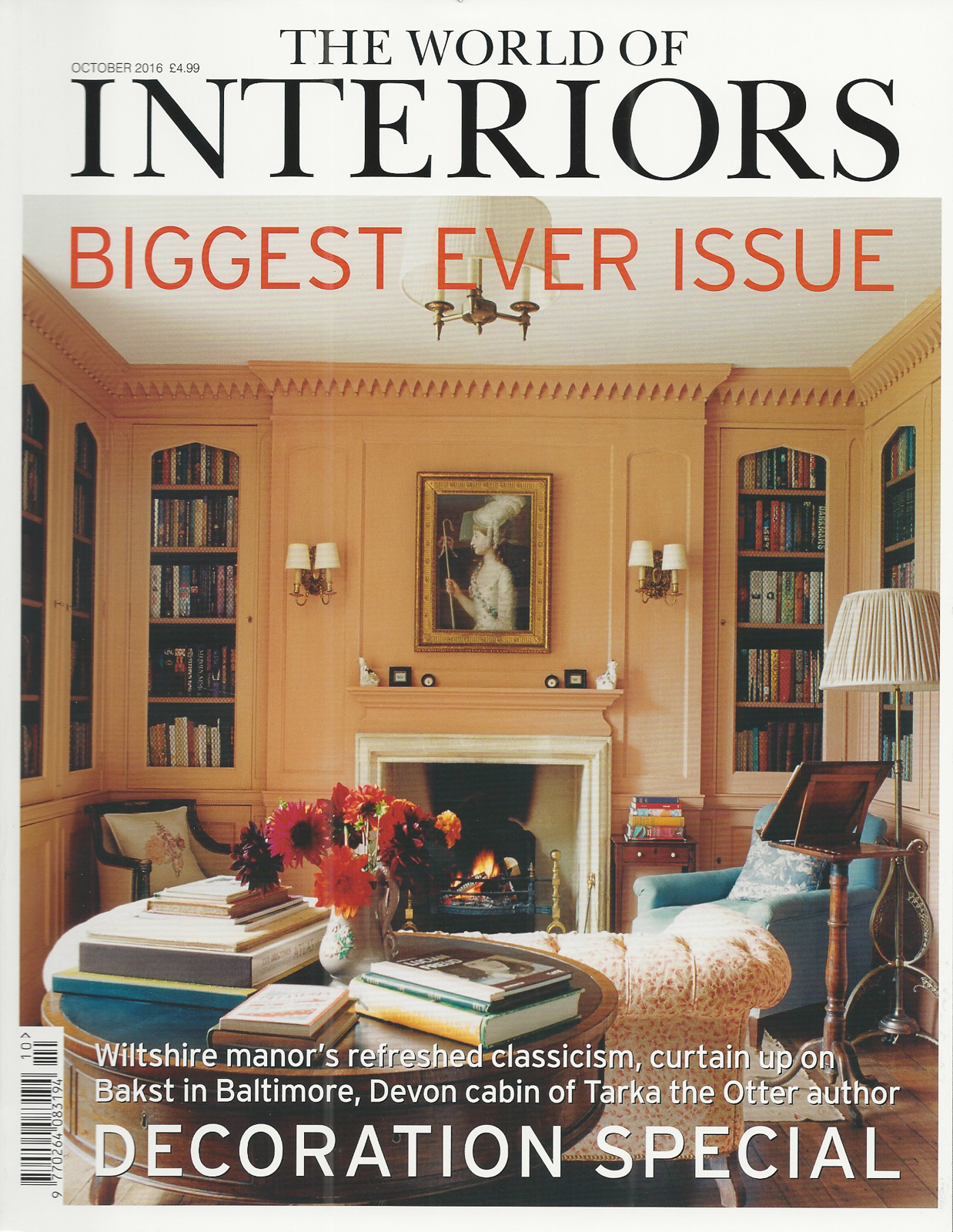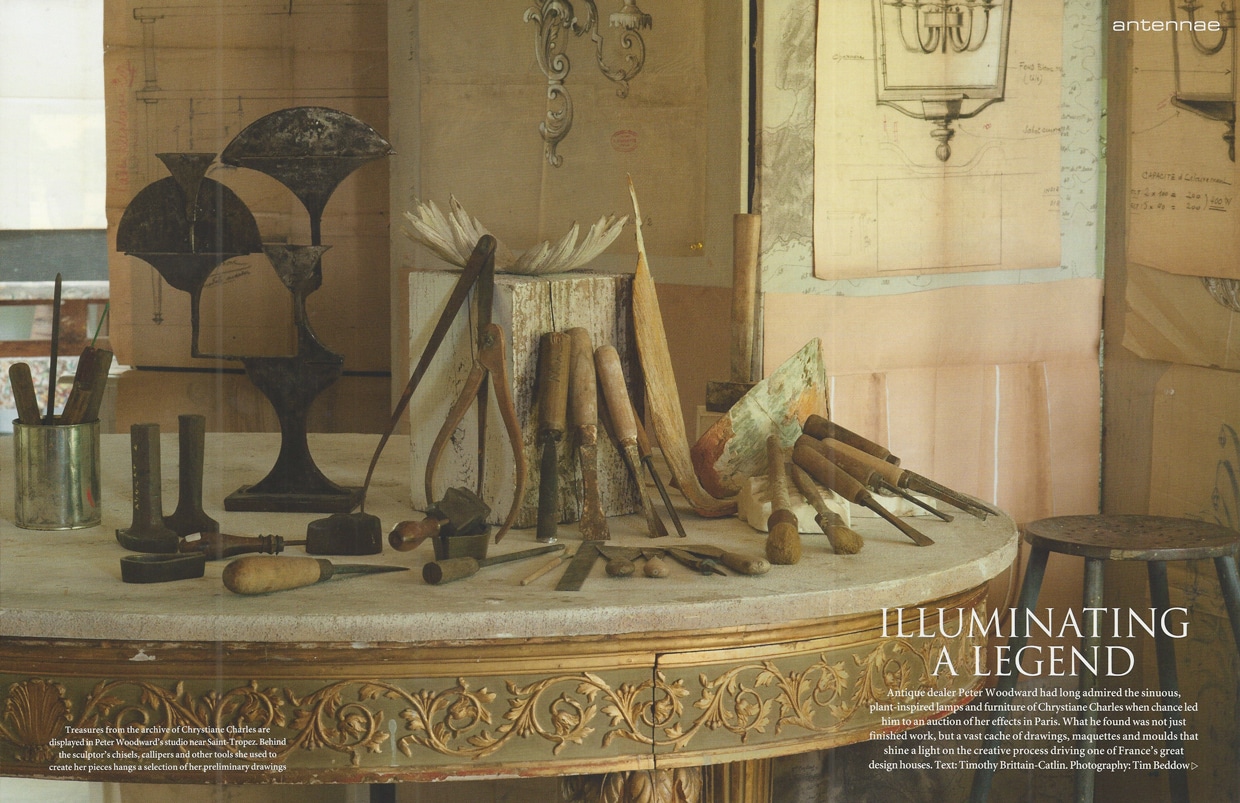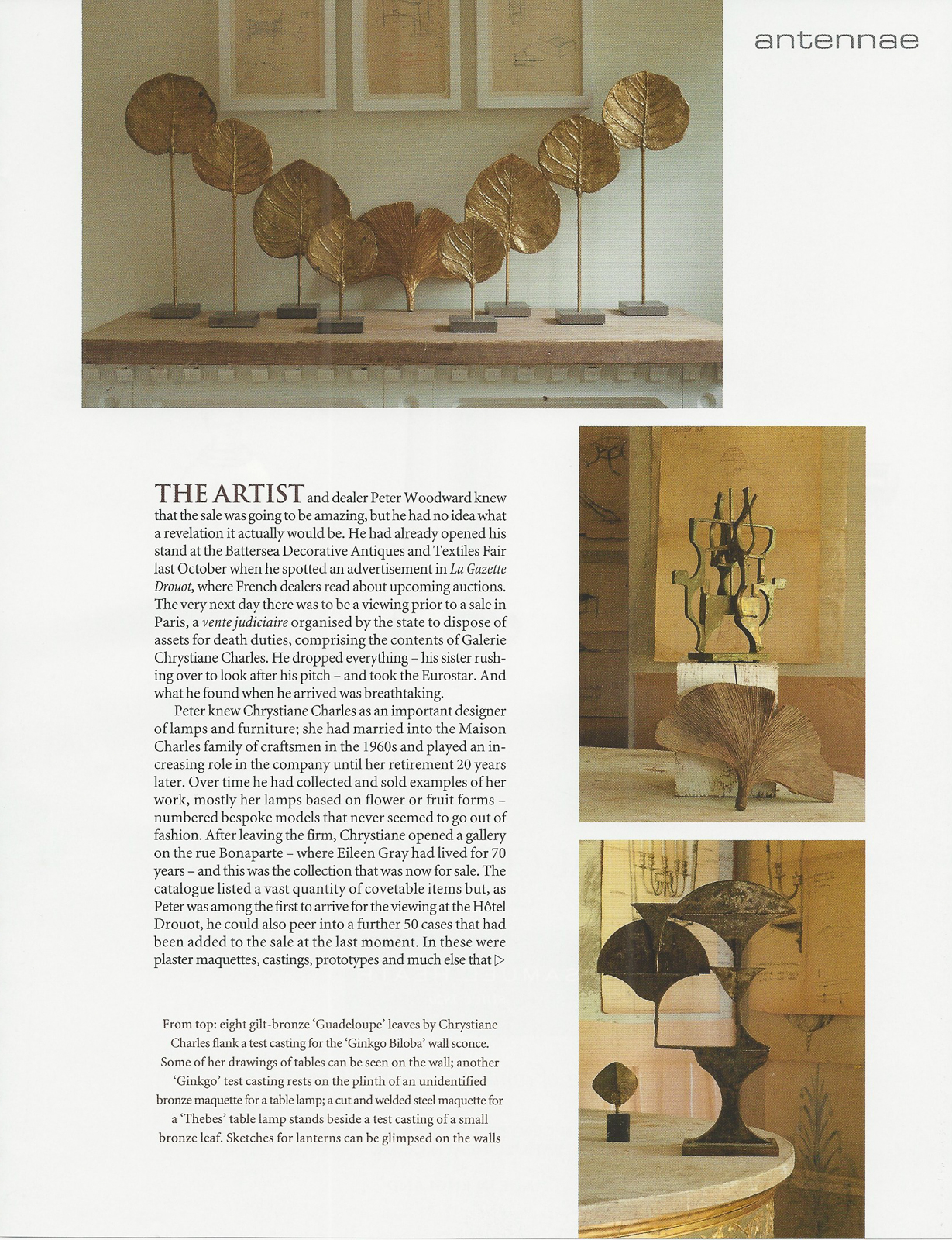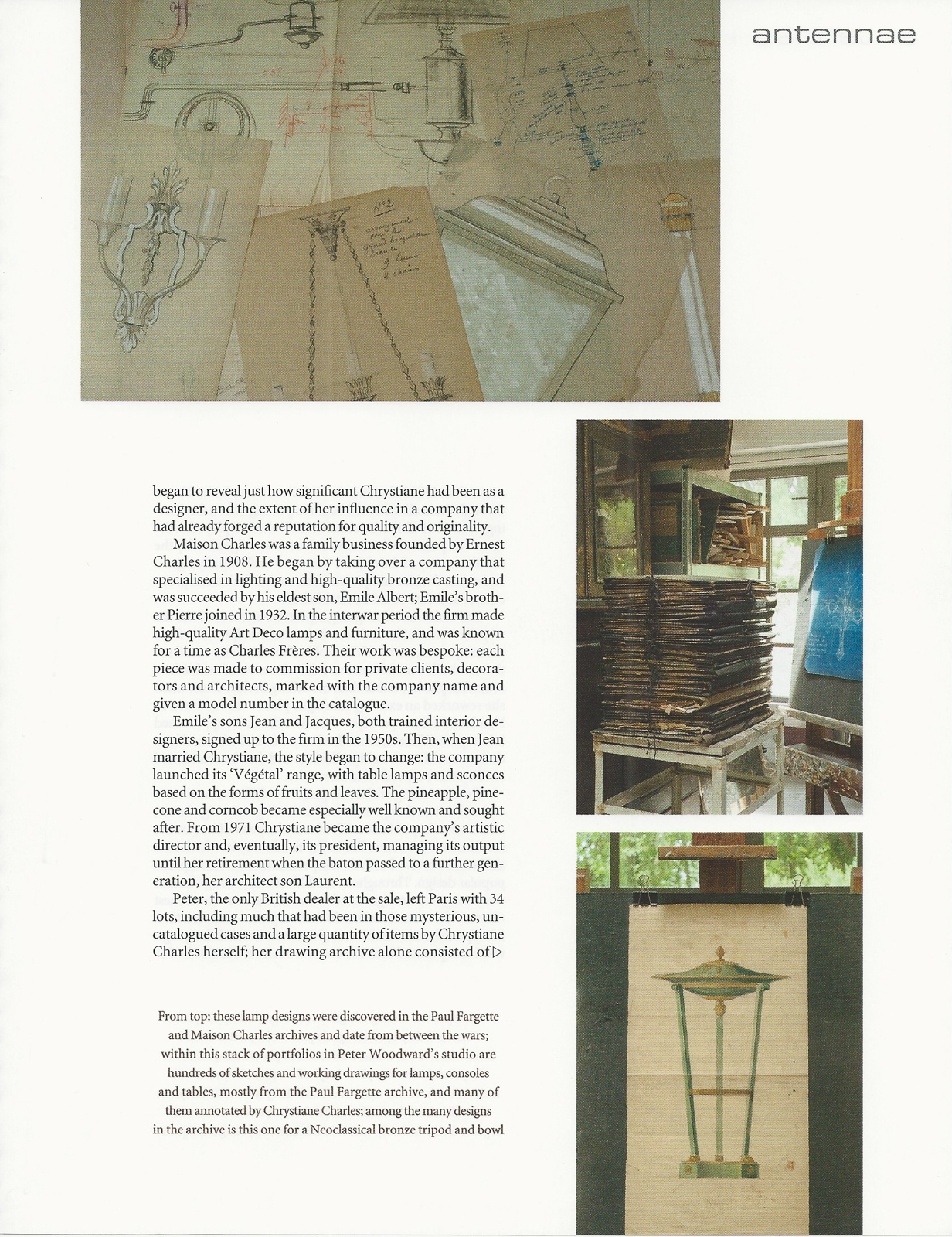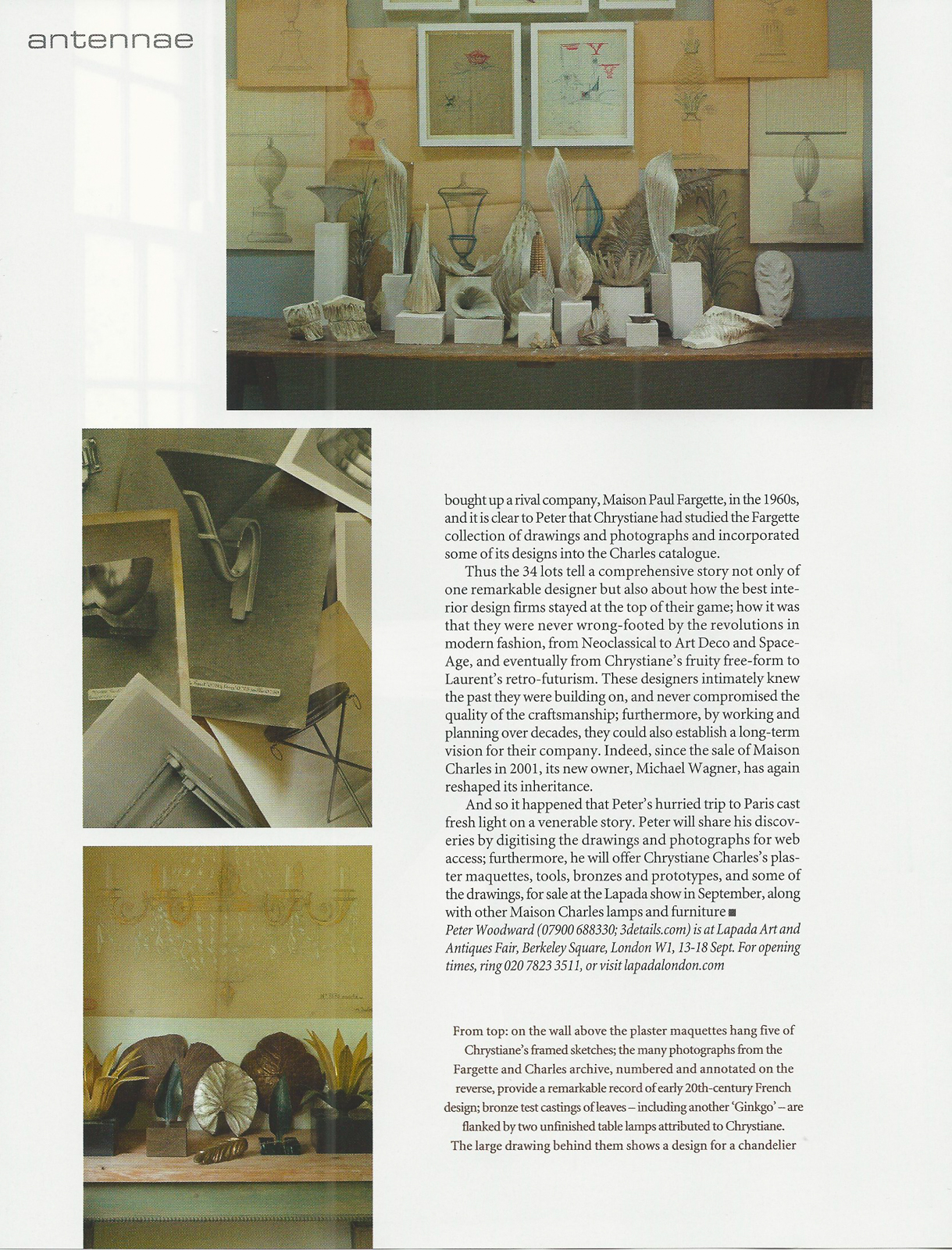For those that missed it, by popular demand here is the complete article published in World of Interiors October 2016 edition.
The article records the discovery, acquisition and reflections upon the Chrystiane Charles’ collection of drawings, photographs, sculptures and ephemera.
© The Condé Nast Publications
Text: Timothy Brittain-Catlin. Photography: Tim Beddow
The artist and dealer Peter Woodward knew
that the sale was going to be amazing, but he had no idea what
a revelation it actually would be. He had already opened his
stand at the Battersea Decorative Antiques and Textiles Fair
last October when he spotted an advertisement in La Gazette
Drouot, where French dealers read about upcoming auctions.
The very next day there was to be a viewing prior to a sale in
Paris, a vente judiciaire organised by the state to dispose of
assets for death duties, comprising the contents of Galerie
Chrystiane Charles. He dropped everything — his sister rush-
ing over to look after his pitch – and took the Eurostar. And
what he found when he arrived was breathtaking.
Peter knew Chrystiane Charles as an important designer
of lamps and furniture; she had married into the Maison
Charles family of craftsmen in the 1960s and played an in-
creasing role in the company until her retirement 20 years
later. Over time he had collected and sold examples of her
work, mostly her lamps based on flower or fruit forms –
numbered bespoke models that never seemed to go out of
fashion. After leaving the firm, Chrystiane opened a gallery
on the rue Bonaparte – where Eileen Gray had lived for 70
years — and this was the collection that was now for sale. The
catalogue listed a vast quantity of covetable items but, as
Peter was among the first to arrive for the viewing at the Hotel
Drouot, he could also peer into a further 50 cases that had
been added to the sale at the last moment. In these were
plaster maquettes, castings, prototypes and much else that
began to reveal just how significant Chrystiane had been as a
designer, and the extent of her influence in a company that
had already forged a reputation for quality and originality.
Maison Charles was a family business founded by Ernest
Charles in 1908. He began by taking over a company that
specialised in lighting and high-quality bronze casting, and
was succeeded by his eldest son, Emile Albert; Emile’s broth-
er Pierre joined in 1932. In the interwar period the firm made
high—quality Art Deco lamps and fumiture, and was known
for a time as Charles Freres. Their work was bespoke: each
piece was made to commission for private clients, decora-
tors and architects, marked with the company name and
given a model number in the catalogue.
Emile’s sons Jean and Jacques, both trained interior de-
signers, signed up to the firm in the 1950s. Then, when Jean
married Chrystiane, the style began to change: the company
launched its ‘Végétal’ range, with table lamps and sconces
based on the forms of fruits and leaves. The pineapple, pine-
cone and corncob became especially well known and sought
after. From 1971 Chrystiane became the company’s artistic
director and, eventually, its president, managing its output
until her retirement when the baton passed to a further gen-
eration, her architect son Laurent.
Peter, the only British dealer at the sale, left Paris with 34
lots, including much that had been in those mysterious, un-
catalogued cases and a large quantity of items by Chrystiane
Charles herself; her drawing archive alone consisted of
more than 2,000 sketches in 36 folios. Once he had been
through them all, he could begin to put together a fascinat-
ing portrait of Chrystiane and the role she had played at the
firm. The point at which she took over was signalled by the
fact that many of the objects were now individually signed
and marked with a unique number, so that their exact prov-
enance and date could be established.
One of the most intriguing aspects he uncovered was the
way she worked. She had been trained as a sculptor, but from
the maquettes, many of them of leaf forms, Peter could see
that she built a metal armature that she covered with fabric
soaked in plaster, rather than modelling in clay. Thus, when
she reworked an existing catalogue piece — an Art Deco or
Neoclassical form, perhaps – for a new client, she approached
it in a quite different, more fluid way. Peter also learned how
designs could reach a chrysalis stage and then be abandoned
as Chrystiane moved on to a new idea.
This reworking of classical pieces for different customers
and as fashions change is the hallmark of a great design house,
and is what kept Maison Charles at the peak of its powers
for decades: the secret lies in the subtle way in which new
skills and a revived artistic temperament can reinterpret a
popular design. Throughout the 20th century, design houses
were bought or amalgamated — after all, that was how Ernest
Charles had created the firm in the first place – and each time
it happened, a new archive, and thus a new artistic language,
was incorporated into the oeuvre. Maison Charles had
bought up a rival company, Maison Paul Fargette, in the 1960’s,
and it is clear to Peter that Chrystiane had studied the Fargette
collection of drawings and photographs and incorporated
some of its designs into the Charles catalogue.
Thus the 34 lots tell a comprehensive story not only of
one remarkable designer but also about how the best inte-
rior design firms stayed at the top of their game; how it was
that they were never wrong-footed by the revolutions in
modern fashion, from Neoclassical to Art Deco and Space-
Age, and eventually from Chrystiane’s fruity free-form to
Laurent’s retro-futurism. These designers intimately knew
the past they were building on, and never compromised the
quality of the craftsmanship; furthermore, by working and
planning over decades, they could also establish a long-term
vision for their company. Indeed, since the sale of Maison
Charles in 2001, its new owner, Michael Wagner, has again
reshaped its inheritance.
And so it happened that Peter’s hurried trip to Paris cast
fresh light on a venerable story. Peter will share his discov-
eries by digitising the drawings and photographs for web
access; furthermore, he will offer Chrystiane Charles’s plas-
ter maquettes, tools, bronzes and prototypes, and some of
the drawings, for sale at the Lapada show in September, along
with other Maison Charles lamps and furniture .
Peter Woodward (07900 688330; 3details.com) is at Lapada Art and
Antiques Fair, Berkeley Square, London W1, 13-18 Sept. For opening
times, ring 020 7823 3511, or visit lapadalondon.com
read more about Maison Charles here
